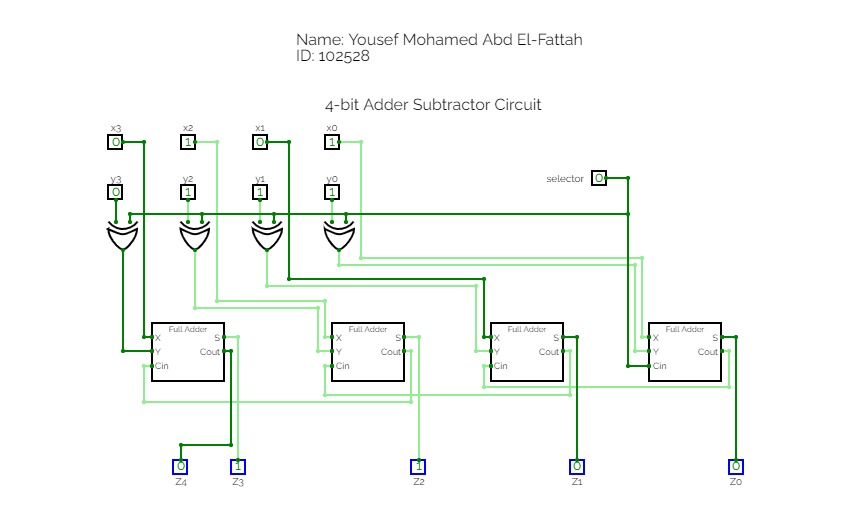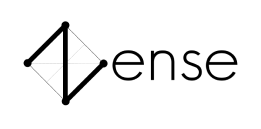Adder subtractor Circuit detail explanation
Adder subtractor Circuit detail explanationCircuit Verse should be used only to create the project – online simulator https://circuitverse.org/simulator
All screenshots should include clear evidence for the student names and the date and time taken.
Start building the 4-bit adder subtractor circuit from the half adder until you reach the final circuit results.
Build the 1-bit half adder circuit and convert it into symbol (block).
Build the 1-bit full adder circuit and convert it into symbol (block).
Build the 4-bit adder circuit and convert it into symbol (block).
Build the 4-bit adder subtractor and convert it into symbol (block).
Build the final circuit
Build the 1-bit half adder circuit and convert it into symbol (block).
Write a detailed explanation about the full adders.
Insert your screenshot and the explanation here
I want to sum 2 binary digits (A,B) and the sum of 2 binary numbers needs (at most) 2 output digits;
so from truth table:
A
B
Sum
Carry
0
0
0
0
0
1
1
0
1
0
1
0
1
1
0
1
Sum: S = (A.B’) + (A’.B) = A⨁ B
Carry: C = A.B
Build the 1-bit full adder circuit and convert it into symbol (block).
Write a detailed explanation about the full adders.
Insert your screenshot and the explanation here
I want to sum 3 binary digits (X ,Y , Cin) and the sum of 3 binary numbers needs (at most) 2 output digits (S , Cout).
X
Y
Cin
Sum
Carry
0
0
0
0
0
0
0
1
1
0
0
1
0
1
0
0
1
1
0
1
1
0
0
1
0
1
0
1
0
1
1
1
0
0
1
1
1
1
1
1
Sum = (X’ .Y’ .Cin) + (X’ .Y .Cin’) + (X .Y’ .Cin’) + (X .Y .Cin)
= X’ .((Y’ .Cin) + (Y .Cin’)) + X .((Y’ .Cin’) + (Y .Cin))
= X’ .(Y⨁ Cin) + X .(Y⨁ Cin)’
= X ⨁ Y ⨁ Cin
Carry = (X’ .Y .Cin) + (X .Y’ .Cin) + (X .Y .Cin’) + (X .Y .Cin)
= Cin .(X⨁ Y) + X .Y
since: Sum [from Full Adder (F.A.)] = X ⨁ Y ⨁ Cin
= Sum1 [from Half Adder (H.A.)] ⨁ Cin
Carry [from Full Adder (F.A.)] = X .Y + Cin .(X⨁ Y)
= Carry1 [from Half Adder (H.A.)] + Cin .(X⨁ Y)
I can use 1 Half Adder to get [Sum1 from H.A. = X⨁ Y] and [Carry1 from H.A. = X.Y]
then I can use anther 1 Half Adder with (first Sum form H.A. & Cin) to get:
===> Sum =[(Sum1 from H.A.) ⨁ Cin] = X ⨁ Y ⨁ Cin <=== that’s the final Sum
and Carry2 [from second Half Adder (H.A.)] = Cin .(X⨁ Y)
If I passed the two Carry outputs (Carry1 & Carry2) through OR gate; I will get the final Carry:
===> final Carry = Carry1 + Carry2 = X .Y + Cin .(X⨁ Y) <=== that’s the final Carry
So, we can use 2 H.A. & OR gate to construct Full Adder.
Build the 4-bit adder circuit and convert it into symbol (block).
Write a detailed explanation about how it works.
Insert your screenshot and the explanation here
since Half Adder Circuit (H.A.) can sum 2 digits
since Full Adder Circuit (F.A.) can sum 3 digits at once
It’s generally used Full Adder (F.A.) Circuits to sum 2 digits (1-digit from input x & 1-digit from input y) and add to them the carry (in the third input digit) from previous sum operation.
Ofcourse first 1-bit adder doesn’t need 3 input digits (because of there is no Carry);
So I used H.A. Circuit in first 1-bit Adder.
Build the 4-bit adder subtractor and convert it into symbol (block).
Write a detailed explanation about how it works.
Insert your screenshot and the explanation here
It’s preferred to subtract binary numbers (Z= X - Y) using the 2’s complement method; Which says that we find the 1’s complement to the -ve number (Y) and then add 1 to it;
After that we can use the new input of Y to sum it normally with X using a 4-bit Adder Circuit.
⇒ The complement of every digit of Y = Y’ ⇒ Y’ = {y0’ , y1’ , y2’ , y3’}
so every digit of Y enters on NOT gate to become Y’
⇒ Then add 1 (as a carry) to the Sum of first 1-bit Full Adder(F.A.)
∴The output Z = X - Y [but X must be >= Y]
Build the final circuit
Include screenshots with 4 different random examples and explain each one:
2 addition
2 subtraction
Write detailed explanation about how it works and how you did it.
Insert your screenshots and the explanation here
HOW I DID THIS CIRCUIT:
The Circuit works in 2 options. When I keep [selector = 0] the Circuit is a 4-bit Adder and when I keep [selector = 1] the circuit is a 4-bit Subtractor.
∵The difference between 4-bit adder & 4-bit subtractor is in
1)the input Y (which is converted to Y’ in a 4-bit Subtractor)
2)& the third input digit in the first bit Full adder.
∴For input Y problem:
we need to find the equation that converts Y to Y’ (the 1’s complement) when the [selector = 1]. (i’ll use y0 digit to explain on)
selector
y0
f(y0)
0
0
0
0
1
1
1
0
1
1
1
0
f(y0) = selector ⨁ y0
⇒ ∴the problem of Y is solved when we connect every digit of Y with selector using X-OR gate.
∴For the problem of the third input digit in the first 1-bit Full adder:
we need to keep [the third input digit = 0] when the wanted operation is sum (selector=0) and keep [third input digit = 1] when the operation is subtraction (selector=1)
⇒ ∴ The third input digit in first bit Full adder = selector
Screenshot 1
When the input X=(0101) :{x3=0 , x2=1 , x1=0 , x0=1}
& when the input Y=(0111) : {y3=0 , y2=1 , y1=1 , y0=1}
∵ selector = 0 ∴ The operation is summing (Z = X + Y)
∴ Z0 = sum of three input digits (x0 , y0 , Cin)
Z0= x0 + y0 + selector = 1 + 1 + 0 = 0 [& 1-carried to next bit Full Adder]
Z1= x1 + y1 + Cin = 0 + 1 + 1(carry)= 0 [& 1-carried to next bit Full Adder]
Z2= x2 + y2 + Cin = 1 + 1 + 1(carry)= 1 [& 1-carried to next bit Full Adder]
Z3= x3 + y3 + Cin = 0 + 0 + 1(carry)= 1 [& no carry]
Z4= last carry = 0
∴ Z = 01100
Screenshot 2
When the input X=(1111) :{x3= 1 ,x2= 1 ,x1= 1 ,x0= 1}
& when the input Y=(1111) : {y3= 1 ,y2= 1 ,y1= 1 ,y0= 1}
∵ selector = 0 ∴ The operation is summing (Z = X + Y)
∴ Z0 = sum of three input digits (x0 , y0 , Cin)
Z0= x0 + y0 + Cin = 1 + 1 + selector = 0 [& 1-carried to next bit Full Adder]
Z1= x1 + y1 + Cin = 1 + 1 + 1(carry) = 1 [& 1-carried to next bit Full Adder]
Z2= x2 + y2 + Cin = 1 + 1 + 1(carry) = 1 [& 1-carried to next bit Full Adder]
Z3= x3 + y3 + Cin = 1 + 1 + 1(carry) = 1 [& 1-carried to next bit Full Adder]
Z4= last carry = 1
∴ Z = 11110
Screenshot 3
When the input X=(1111) :{x3= 1 ,x2= 1 ,x1= 1 ,x0= 1}
& when the input Y=(0101) : {y3= 0 ,y2= 1 ,y1= 0 ,y0= 1}
∵ selector = 1 ∴ The operation is subtract (Z = X - Y)
the circuit Subtracts using 2’s complement method:
∴ 1’s complement of Y = Y’ = 1010: {y3’= 1 ,y2’= 0 ,y1’= 1 ,y0’= 0}
∴ Z0 = sum of three input digits (x0 , y0’ , Cin)
Z0= x0 + y0’ + Cin = 1 + 0 + selector = 0 [& 1-carried to next bit Full Adder]
Z1= x1 + y1’ + Cin = 1 + 1 + 1(carry) = 1 [& 1-carried to next bit Full Adder]
Z2= x2 + y2’ + Cin = 1 + 0 + 1(carry) = 0 [& 1-carried to next bit Full Adder]
Z3= x3 + y3’ + Cin = 1 + 1 + 1(carry) = 1 [& 1-carried to next bit Full Adder]
Z4= last carry = 1 (note: we ignore last bit (Z4) in subtract operation & it have to = 1)
when [Z4 = 1] that means [X>=Y]
∴ Z = 1010
Screenshot 4
When the input X=(0111) :{x3= 0 ,x2= 1 ,x1= 1 ,x0= 1}
& when the input Y=(0111) : {y3= 0 ,y2= 1 ,y1= 1 ,y0= 1}
∵ selector = 1 ∴ The operation is subtract (Z = X - Y)
the circuit Subtracts using 2’s complement method:
∴ 1’s complement of Y = Y’ = 1000: {y3’= 1 ,y2’= 0 ,y1’= 0 ,y0’= 0}
∴ Z0 = sum of three input digits (x0 , y0’ , Cin)
Z0= x0 + y0’ + Cin = 1 + 0 + 1(selector)= 0 [& 1-carried to next bit Full Adder]
Z1= x1 + y1’ + Cin = 1 + 0 + 1(carry) = 0 [& 1-carried to next bit Full Adder]
Z2= x2 + y2’ + Cin = 1 + 0 + 1(carry) = 0 [& 1-carried to next bit Full Adder]
Z3= x3 + y3’ + Cin = 0 + 1 + 1(carry) = 0 [& 1-carried to next bit Full Adder]
Z4= last carry = 1 (note: we ignore last bit (Z4) in subtract operation & it have to = 1)
when [Z4 = 1] that means [X>=Y]
∴ Z = 0000








